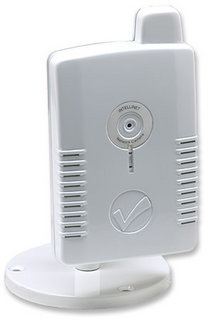 | ||
An Internet protocol camera, or IP camera, is a type of digital video camera commonly employed for surveillance, and which, unlike analog closed circuit television (CCTV) cameras, can send and receive data via a computer network and the Internet. Although most cameras that do this are webcams, the term "IP camera" or "netcam" is usually applied only to those used for surveillance. The first centralized IP camera was Axis Neteye 200, released in 1996 by Axis Communications.
Contents
There are two kinds of IP cameras:
History
The first centralized IP camera was released in 1996 by Axis Communications. It was called the Axis Neteye 200 and was developed by the team of Martin Gren and Carl-Axel Alm. It used a custom web server internal to the camera. In late 1999, the company started using embedded Linux to operate its cameras. Axis also released documentation for its low-level API called "VAPIX", which builds on the open standards of HTTP and real time streaming protocol (RTSP). This open architecture was intended to encourage third-party software manufacturers to develop compatible management and recording software.
The first decentralized IP camera was released in 1999 by Mobotix. The camera's Linux system contained video, alarm, and recording management functions, thus the camera system did not require licensed video management software to manage the recording event, or video management.
The first IP camera with onboard video content analytics (VCA) was released in 2005 by Intellio. This camera was able to detect a number of different events, such as if an object was stolen, a human crossed a line, a human entered a predefined zone, or if a car moved in the wrong direction.
IP cameras are available at resolutions from 0.3 (VGA resolution) to 29 megapixels. As in the consumer TV business, in the early 21st century, there has been a shift towards high-definition video resolutions, e.g. 720p or 1080i and 16:9 widescreen format.
Standards
Previous generations of analog CCTV cameras use established broadcast television formats (e.g. Common Intermediate Format (CIF), NTSC, PAL, and SECAM). IP cameras may differ from one another in features and functions, video encoding (compression) schemes, available network protocols, and the API to be used by video management software.
In order to address issues of standardization of IP video surveillance, two industry groups were formed in 2008: the Open Network Video Interface Forum (ONVIF) and the Physical Security Interoperability Alliance (PSIA). While the PSIA was founded by 20 member companies including Honeywell, GE Security and Cisco, and ONVIF was founded by Axis Communications, Bosch and Sony, each group now has numerous members. As of January 2009, each group had released version 1.0 of their specification.
Potential advantages
IP cameras differ from previous generation analog cameras which transmitted video signals as a voltage, instead IP camera images are sent using the transmission and security features of the TCP/IP protocol, which provides numerous benefits:
Potential disadvantages
Hacking
As with a CCTV/DVR system, if the video is transmitted over the public Internet rather than a private network / intranet, the system potentially becomes open to a wider audience including hackers. Criminals can hack into a CCTV system to disable or manipulate them or observe security measures and personnel, thereby facilitating criminal acts and rendering the surveillance counterproductive. This can be counteracted by ensuring the network and device is secured and staying informed on new security methods. In 2012 users of 4chan hacked into thousands of streaming personal IP cameras by exploiting a vulnerability in some models of Trendnet home security cameras. In 2014 it was reported that a site indexed 73,011 locations worldwide with security cameras that were unprotected by using default usernames and passwords.
